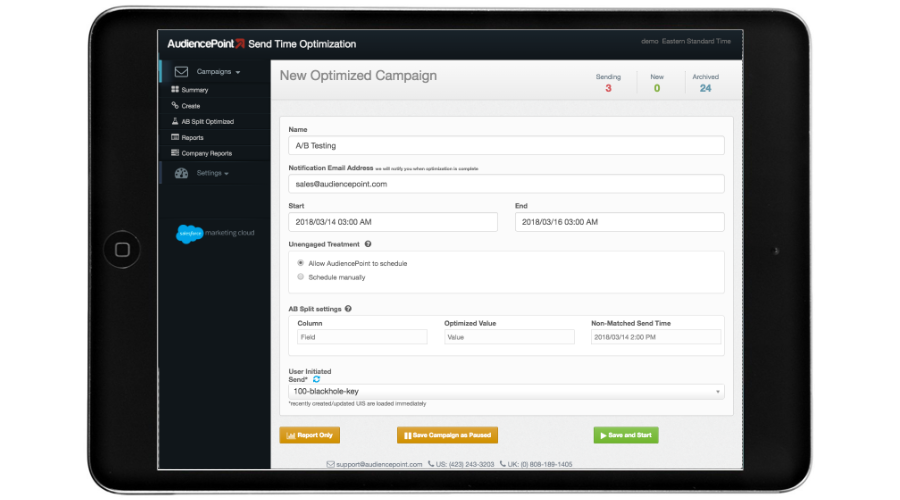AudiencePoint is thrilled to announce our new integration with Klaviyo! AudiencePoint is looking for partners to pilot our...
Monitoring metrics to assess email performance is an excellent way to improve your email engagement strategy. However, you may be wondering what email metrics you should monitor and why each one is important. This article will detail what you need to know about monitoring email metrics and resources that can help.
What Are Email Metrics?
Email metrics are used to track how marketing emails perform. Metrics for email marketing typically consist of how subscribers engage with email content and conversions generated as a result of sending promotional emails. However, there are several different types of email metrics that will vary in importance depending on your company’s needs.
What Email Metrics Do You Monitor?
The most common email metrics to monitor are open rate, click-through rate, conversion rate, bounce rate, and unsubscribe rate:
- Open rate: Email marketing open rate is the percentage of recipients who open your email. Open rate is important since your email content can’t be effective if your subscribers don’t open it. However, this metric has become more difficult to track since Apple integrated its new mail privacy protection (MPP).
- Click-through rate: Email marketing click-through rate is the percentage of recipients who click a link within your email. Click-throughs are a key metric since they show that your content was successful in getting subscribers to take action.
- Conversion rate: Email marketing conversion rate is the percentage of recipients who take a targeted action, such as making a purchase, installing an app, starting a free trial, or signing up for a consultation.
- Bounce rate: Email marketing bounce rate is the percentage of emails sent that aren’t accepted by the receiving domain. Low email engagement can cause emails to bounce more frequently, so ensuring you have good engagement rates, re-engaging inactive subscribers, and removing invalid email addresses will help reduce bounce rates.
- Unsubscribe rate: Email unsubscribe rate is the percentage of unsubscribes out of the total number of emails sent. Maintaining a low unsubscribe rate is a good sign that your email content effectively retains subscribers and keeps them engaged.
Monitoring these common email metrics will give you a good baseline for how your emails are performing. For more help monitoring metrics, using tools like an email metrics dashboard can help you make sense of the wide variety of email metrics that can be monitored.
What Do Email Marketing Metrics Include?
While the most common metrics give you a good baseline, there are many email metrics you could track. Email metrics can include sales and website traffic created directly from email marketing, the growth of your email list, subscriber experience metrics, and even customer service email metrics. The importance of each of these types of metrics will vary depending on your company and marketing objectives.
What Are Considered Good Customer Service Performance Metrics?
Some common customer service metrics through email are customer satisfaction (CSAT) score, first response time, resolution time, and tickets solved. Good performance metrics for each of these are:
- CSAT: Customer satisfaction between 75-85% is typically considered good in most industries. However, every company should aim to get customer satisfaction as high as possible.
- First response time: A good first response time for an email customer service request is within four hours. While it might not be feasible to have customer service representatives staffed around the clock, getting first responses out as quickly as possible should be the goal.
- Resolution time: For customer service emails, aiming for less than 24 hours to get a resolution would be a good goal to strive to achieve. Otherwise, within 48 hours is still an acceptable range for most problems. However, inevitably some issues can take longer to resolve than others.
- Tickets solved: A customer service agent can typically solve between 20-30 email service requests daily, since many have simple solutions. However, this number can vary on a daily basis and depends on the company.
Now that you know some benchmarks for email customer service metrics, you can properly implement strategies to improve customer service through email.
What Is the Average Email Open Rate?
The combined average email open rate for all industries is 21.33%, excluding Apple MPP opens. The average open rate gives a good benchmark for companies in most industries to strive to achieve or exceed with their email marketing campaigns.
Keeping track of benchmarks for open rate, along with other key metrics like click-through rate and conversion rate, will help you measure email marketing success against competitors.
What Is the Average Email Click-Through Rate
The combined average click-through rate for all industries is 2.62%. Achieving a click-through rate of 2.62% or higher shows that your email and call to action were successful in getting subscribers to take the next step in the buying process.
Email Marketing Conversion Rate 2022
Most companies’ average email conversion rate is at or slightly below 1.5%. While this can seem like a low percentage point, there are many strategies you can use to boost conversions, like improving calls to action, more engaging subject lines, improving send times, and segmenting email campaigns. If you’re looking to improve email conversions and other essential metrics, AudiencePoint can help.
How AudiencePoint Can Help Improve Your Email Marketing
AudiencePoint’s email insight software, ListFit, can help optimize your email marketing strategy through easy-to-implement tools that give you actionable data on your email performance. Our tools help you optimize send times, analyze email performance, and get insights into subscriber activity.
All this data helps you get a better idea of how to create engaging content for your audience, segment email lists, and send emails when subscribers are most likely to check their inboxes.
If this sounds like it would be useful for your business, contact us to learn more about how AudiencePoint can help you.





